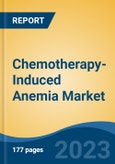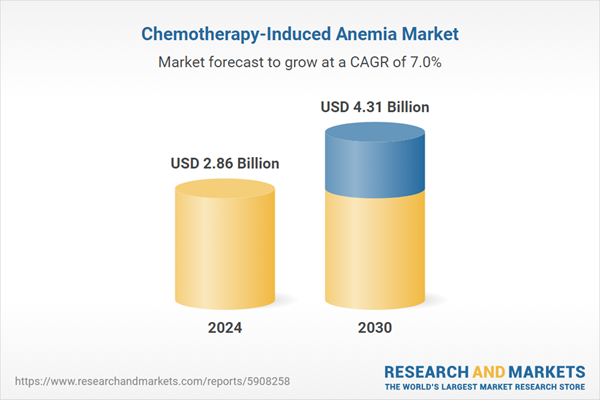Speak directly to the analyst to clarify any post sales queries you may have.
10% Free customizationThis report comes with 10% free customization, enabling you to add data that meets your specific business needs.
Chemotherapy-induced anemia is a common side effect of chemotherapy, occurring when chemotherapy drugs impair the bone marrow’s ability to produce red blood cells, thereby reducing hemoglobin levels in the blood. This condition can result in symptoms such as fatigue, weakness, shortness of breath, and a reduced tolerance for further cancer treatments. As a result, the management of CIA has become a key aspect of cancer care, leading to increased demand for effective treatments.
CIA affects a wide range of cancer patients, with the American Cancer Society reporting that 30-90% of cancer patients undergoing chemotherapy experience varying degrees of anemia. Treatments for CIA include erythropoiesis-stimulating agents (ESAs), iron supplements, blood transfusions, and emerging therapies. ESAs, including erythropoietin-stimulating agents and darbepoetin alfa, have been commonly used to manage the condition, although safety concerns and regulatory changes have impacted their usage. Key players in the CIA market include major pharmaceutical companies such as Amgen, Johnson & Johnson, and Roche, which are developing and marketing treatments for this condition.
The CIA market is dynamic, presenting both challenges and opportunities. Regulatory concerns and reimbursement issues pose significant hurdles, but ongoing research, patient-centered care, industry collaboration, and market expansion offer a promising future. As the healthcare industry continues to prioritize cancer patient well-being, advancements in CIA management will be crucial to improving the quality of life for those undergoing chemotherapy. Pharmaceutical companies and healthcare providers must remain agile and innovative to meet the needs of this growing patient population.
Key Market Drivers
Increasing Incidence of Cancer: The global incidence of cancer is a significant driver of the chemotherapy-induced anemia market. As cancer cases continue to rise, so does the demand for effective treatments, including chemotherapy. Despite its effectiveness, chemotherapy is associated with side effects such as CIA, which is gaining increased attention. The rising cancer incidence is prompting research, innovation, and the development of therapies to manage this condition.According to the World Cancer Research Fund, there were 19,976,499 cancer cases worldwide in 2022, including non-melanoma skin cancer. Excluding non-melanoma skin cancer, the number of cases was 18,741,966, with nearly equal distribution between men (9,566,825 cases) and women (9,175,141 cases).
Key Market Challenges
Regulatory Barriers: Regulatory hurdles pose significant challenges for companies in the CIA market. Navigating the complex regulatory environment requires substantial resources and time. Regulatory agencies, including the FDA and EMA, require extensive preclinical and clinical data to evaluate the safety and efficacy of new therapies. This process is often lengthy and costly, delaying time to market and increasing financial strain for companies. Regulatory requirements also vary across regions, further complicating international market expansion. Smaller firms, in particular, face challenges competing with larger, more established companies with greater resources and experience in managing regulatory processes.Key Market Trends
Rising Awareness and Early Diagnosis of Chemotherapy-Induced Anemia: Increasing awareness and early diagnosis of CIA is a major driver of the global market. As cancer incidence grows and treatment regimens become more complex, there is greater recognition of the impact of chemotherapy-induced anemia on patients’ quality of life. Previously underdiagnosed or underappreciated, CIA is now receiving more attention from healthcare professionals, leading to an increased demand for treatment options.Key Market Players
- Dr. Reddy's Laboratories Ltd.
- Pfizer Inc.
- Panacea Biotec Limited
- SBI Pharmaceuticals Co., Ltd.
- Sumitomo Dainippon Pharma Co., Ltd.
- PharmaEssentia Corp.
- PhytoHealth Corp
- UBI Pharma Inc.
- Amgen Inc.
- Astellas Pharma Inc.
Report Scope
This report segments the Global Chemotherapy-Induced Anemia Market as follows:
By Disease Type:
- Mild Anemia
- Moderate Anemia
- Severe Anemia
By Treatment Type:
- RBC Transfusions
- Erythropoiesis-Stimulating Agents (ESAs)
- Iron Supplementation
By Drug Type:
- Epogen Injection
- Procrit Injection
- Androxy Oral
- Aranesp Injection
- Epoetin Alfa Injection
- Others
By End User:
- Hospitals & Clinics
- Ambulatory Care Centers
- Others
By Region:
North America:
United States, Canada, MexicoEurope:
France, United Kingdom, Italy, Germany, SpainAsia-Pacific:
China, India, Japan, Australia, South KoreaSouth America:
Brazil, Argentina, ColombiaMiddle East & Africa:
South Africa, Saudi Arabia, UAECompetitive Landscape
This section provides a detailed analysis of the major companies operating in the Chemotherapy-Induced Anemia Market.Available Customizations
The Global Chemotherapy-Induced Anemia market report offers the following customizations tailored to the needs of specific companies:
- Detailed analysis and profiling of additional market players (up to five).
This product will be delivered within 1-3 business days.
Table of Contents
Companies Mentioned
- Dr. Reddy's Laboratories Ltd.
- Pfizer Inc.
- Panacea Biotec Limited
- SBI Pharmaceuticals Co., Ltd
- Sumitomo Dainippon Pharma Co., Ltd.
- PharmaEssentia Corp.
- PhytoHealth Corp
- UBI Pharma Inc.
- Amgen Inc.
- Astellas Pharma Inc.
Table Information
| Report Attribute | Details |
|---|---|
| No. of Pages | 185 |
| Published | February 2025 |
| Forecast Period | 2024 - 2030 |
| Estimated Market Value ( USD | $ 2.86 Billion |
| Forecasted Market Value ( USD | $ 4.31 Billion |
| Compound Annual Growth Rate | 7.0% |
| Regions Covered | Global |
| No. of Companies Mentioned | 10 |









